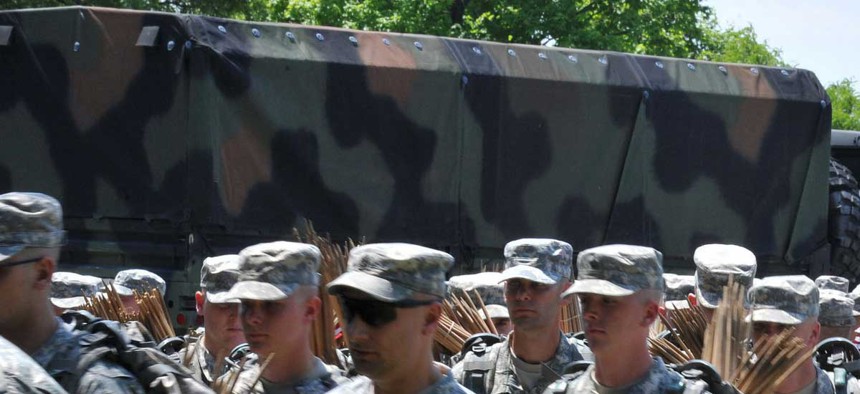
Soldiers from the Army's 3rd Infantry Regiment place flags at Arlington National Cemetary prior to Memorial Day weekend. Veterans Affairs Department
The Future of VA Reform Can Be Found in Everything This Week’s Bill Left Out
It’s important to note what the VA reform bill doesn’t accomplish as a blueprint for Congressional action after the August recess. By Alex Nicholson
As Congress heads into its annual August recess next week, Members will fly off into the sunset finally having jointly achieved something substantive – a comprehensive emergency Department of Veterans’ Affairs reform bill that garnered near-unanimous bipartisan support. But almost as surprising as the level of consensus around this package of compromise solutions is the amount of misinformation floating around about what the bill actually does, what it does not do, and how it evolved.
In early June, as the media and American public became laser-focused about the growing revelations of scandals and cover-ups at the VA, Congress began scrambling to come up with a quick fix to deal with the crisis. The House of Representatives, which had already held multiple dozens of oversight hearings and passed numerous bipartisan bills to address VA’s shortfalls, quickly passed another set of bills to deal with VA’s immediate needs. The Senate, in which a previous attempt to bring one package of veterans legislation to the floor had been set up to fail, canceled the one legislative hearing on new veterans bills that it had scheduled for the year to redirect attention to a new set of proposals related to the crisis.
The basis of the emergency access provisions within the bill originated with a trio of Senate Republicans, namely Sens. Richard Burr, R-N.C., John McCain, R-Ariz., and Tom Coburn,R-Okla. After staff from their respective offices met with veteran service and advocacy organizations to solicit input on how best to structure a “choice card” benefit for veterans who lived more than 40 miles from a VA facility or were waiting more than 30 days for appointments, a bill that was originally referred to as the McCain-Burr bill was released.
Fairly soon thereafter, stories about veterans dying while lingering for months on secret appointment waiting lists in Arizona, Texas, Colorado and elsewhere began to catch fire with the media. It was then that a second go-round at the previous, broader veteran legislative package was postponed by Senate Veterans Affairs Committee Chairman Sen. Bernie Sanders, I-Vt., who began working with Sens. McCain and Burr to build on their new emergency health care access bill as a quick-fix for an overburdened VA system in crisis.

An accountability provision that House Veterans’ Affairs Committee Chairman Rep. Jeff Miller, R-Fla., previously developed and steered to passage in the House was also brought into the mix. While this provision only applied to Senior Executive Service employees at the VA, of which there are fewer than 500, the red-tape-busting nature of this provision to allow the secretary to more easily fire negligent or under-performing senior staff sends a strong message throughout the troubled department.
Sanders, who is ferociously protective of the VA, also insisted on adding in other widely supported provisions to buttress and strengthen the VA health care system in the intermediate and long-terms—such as funding for hiring additional health care providers and leasing 27 new major medical facilities in 18 states to increase the system’s capacity and infrastructure. And to top things off, Sanders also threw in several non-access-related provisions that had already cleared his Senate committee and the full House without controversy, including a valuable in-state tuition provision for student veterans and reforms to policies and procedures for dealing with military sexual assault.
Despite the progress embodied in this emergency legislation, equally important to remember is what it will not accomplish, which should serve as a blueprint for what Congress should tackle when it returns from the August recess. The new VA accountability provision does not impact more than 99 percent of VA’s employees, including those who were directly—and perhaps criminally—responsible for the secret waitlists and veteran deaths to begin with. Those are either Title 38 or General Schedule employees whose extensive protections from real accountability remain in place and must be dealt with.
These employees also continue to be eligible for sizeable bonuses. Rep. Jeff Miller had proposed a moratorium of bonuses at the VA, but Sen. Sanders insisted on reinstituting the bonus benefit and the compromise result was only a ten percent reduction in the pool of money available to VA to pay out said bonuses. Contrary to some reports, the legislation did not give out new bonuses, but rather only restricted the bonus pool by one-tenth. However, with more stories of negligent employees still receiving sizable bonuses despite negative patient outcomes, this will issue will need to be revisited and resolved as well.

Also left on the table was a substantive response to another growing crisis within the veterans community—that of suicide. With an estimated 22 veterans dying of suicide per day, the few provisions within this bill that may touch on this additional crisis will not be nearly enough to stem the tide of suicide within the veteran population. Rep. Jeff Miller and Rep. Tim Walz, D-Minn., recently introduced a comprehensive package of legislation, the Clay Hunt Suicide Prevention for America’s Veterans Act, to address veteran suicide, and these provisions will need to be quickly acted upon by the House and Senate and passed before Congress recesses again to campaign for re-election in October.
In the longer-term, Congress will need to become more proactive and less reactive. It will need to stop governing and legislating crisis-to-crisis and actually deal with the pervasive issues that are being reported by veterans, flagged by advocacy groups, and uncovered in oversight hearings. And the Senate will need to actually start engaging in substantive and consistent oversight, as well as moving bipartisan legislation on the floor to match the productivity of the House on veterans’ issues.
NEXT STORY: The Army Is Developing 3D Printers to Make Food




